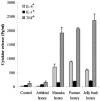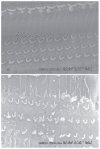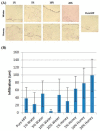Honey-Based Templates in Wound Healing and Tissue Engineering
- PMID: 29903998
- PMCID: PMC6027142
- DOI: 10.3390/bioengineering5020046
Honey-Based Templates in Wound Healing and Tissue Engineering
Abstract
Over the past few decades, there has been a resurgence in the clinical use of honey as a topical wound treatment. A plethora of in vitro and in vivo evidence supports this resurgence, demonstrating that honey debrides wounds, kills bacteria, penetrates biofilm, lowers wound pH, reduces chronic inflammation, and promotes fibroblast infiltration, among other beneficial qualities. Given these results, it is clear that honey has a potential role in the field of tissue engineering and regeneration. Researchers have incorporated honey into tissue engineering templates, including electrospun meshes, cryogels, and hydrogels, with varying degrees of success. This review details the current state of the field, including challenges which have yet to be overcome, and makes recommendations for the direction of future research in order to develop effective tissue regeneration therapies.
Keywords: Inflammation; Manuka honey; chronic wound; cryogel; electrospinning; hydrogel; tissue engineering; tissue regeneration.
Conflict of interest statement
Gary Bowlin has a financial interest in SweetBio Inc.
Figures






Similar articles
-
Manuka Honey Reduces NETosis on an Electrospun Template Within a Therapeutic Window.Polymers (Basel). 2020 Jun 26;12(6):1430. doi: 10.3390/polym12061430. Polymers (Basel). 2020. PMID: 32604824 Free PMC article.
-
A preliminary in vitro evaluation of the bioactive potential of cryogel scaffolds incorporated with Manuka honey for the treatment of chronic bone infections.J Biomed Mater Res B Appl Biomater. 2018 Jul;106(5):1918-1933. doi: 10.1002/jbm.b.34002. Epub 2017 Sep 27. J Biomed Mater Res B Appl Biomater. 2018. PMID: 28960886
-
Investigating Manuka Honey Antibacterial Properties When Incorporated into Cryogel, Hydrogel, and Electrospun Tissue Engineering Scaffolds.Gels. 2019 Apr 18;5(2):21. doi: 10.3390/gels5020021. Gels. 2019. PMID: 31003516 Free PMC article.
-
A Comprehensive Review of Honey-Containing Hydrogel for Wound Healing Applications.Gels. 2025 Mar 12;11(3):194. doi: 10.3390/gels11030194. Gels. 2025. PMID: 40136899 Free PMC article. Review.
-
Health Benefits of Manuka Honey as an Essential Constituent for Tissue Regeneration.Curr Drug Metab. 2017;18(10):881-892. doi: 10.2174/1389200218666170911152240. Curr Drug Metab. 2017. PMID: 28901255 Review.
Cited by
-
Modulating the Antioxidant Response for Better Oxidative Stress-Inducing Therapies: How to Take Advantage of Two Sides of the Same Medal?Biomedicines. 2022 Mar 31;10(4):823. doi: 10.3390/biomedicines10040823. Biomedicines. 2022. PMID: 35453573 Free PMC article. Review.
-
Honey Combination Therapies for Skin and Wound Infections: A Systematic Review of the Literature.Clin Cosmet Investig Dermatol. 2020 Nov 24;13:875-888. doi: 10.2147/CCID.S282143. eCollection 2020. Clin Cosmet Investig Dermatol. 2020. PMID: 33262630 Free PMC article. Review.
-
Applications of honeybee-derived products in bone tissue engineering.Bone Rep. 2024 Jan 19;20:101740. doi: 10.1016/j.bonr.2024.101740. eCollection 2024 Mar. Bone Rep. 2024. PMID: 38304620 Free PMC article. Review.
-
Manuka Honey/2-Hydroxyethyl Methacrylate/Gelatin Hybrid Hydrogel Scaffolds for Potential Tissue Regeneration.Polymers (Basel). 2023 Jan 24;15(3):589. doi: 10.3390/polym15030589. Polymers (Basel). 2023. PMID: 36771889 Free PMC article.
-
Comparison of Honey versus Polylactide Anti-Adhesion Barrier on Peritoneal Adhesion and Healing of Colon Anastomosis in Rabbits.Open Access Maced J Med Sci. 2019 May 25;7(10):1597-1601. doi: 10.3889/oamjms.2019.284. eCollection 2019 May 31. Open Access Maced J Med Sci. 2019. PMID: 31210807 Free PMC article.
References
-
- Ball D.W. The chemical composition of honey. J. Chem. Educ. 2007;84:1643. doi: 10.1021/ed084p1643. - DOI
-
- White J., Doner L.W. Honey composition and properties. Beekeep. U. S. Agric. Handb. 1980;335:82–91.
Publication types
LinkOut - more resources
Full Text Sources
Other Literature Sources
Miscellaneous

